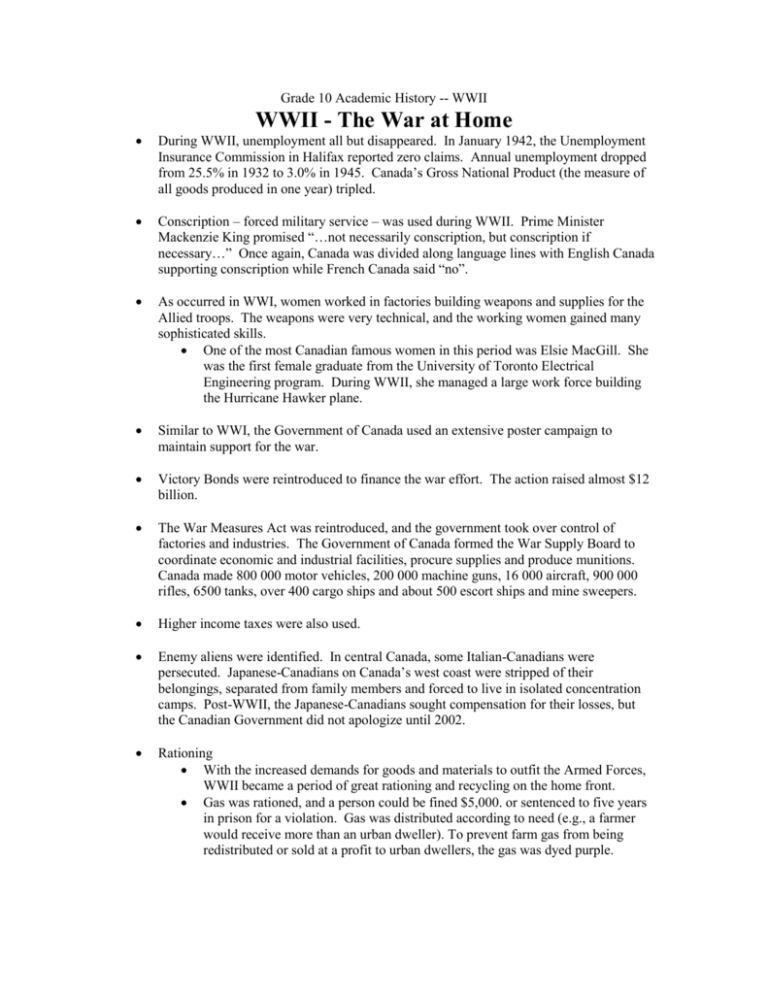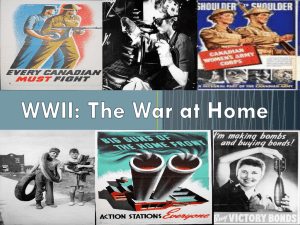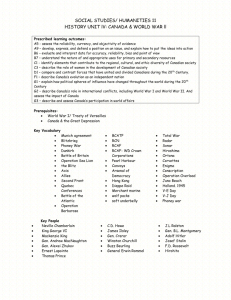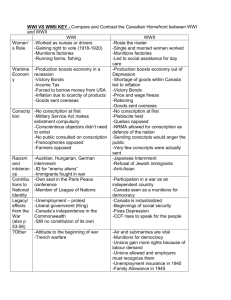Lesson 4 - War at Home
advertisement

Grade 10 Academic History -- WWII WWII - The War at Home During WWII, unemployment all but disappeared. In January 1942, the Unemployment Insurance Commission in Halifax reported zero claims. Annual unemployment dropped from 25.5% in 1932 to 3.0% in 1945. Canada’s Gross National Product (the measure of all goods produced in one year) tripled. Conscription – forced military service – was used during WWII. Prime Minister Mackenzie King promised “…not necessarily conscription, but conscription if necessary…” Once again, Canada was divided along language lines with English Canada supporting conscription while French Canada said “no”. As occurred in WWI, women worked in factories building weapons and supplies for the Allied troops. The weapons were very technical, and the working women gained many sophisticated skills. One of the most Canadian famous women in this period was Elsie MacGill. She was the first female graduate from the University of Toronto Electrical Engineering program. During WWII, she managed a large work force building the Hurricane Hawker plane. Similar to WWI, the Government of Canada used an extensive poster campaign to maintain support for the war. Victory Bonds were reintroduced to finance the war effort. The action raised almost $12 billion. The War Measures Act was reintroduced, and the government took over control of factories and industries. The Government of Canada formed the War Supply Board to coordinate economic and industrial facilities, procure supplies and produce munitions. Canada made 800 000 motor vehicles, 200 000 machine guns, 16 000 aircraft, 900 000 rifles, 6500 tanks, over 400 cargo ships and about 500 escort ships and mine sweepers. Higher income taxes were also used. Enemy aliens were identified. In central Canada, some Italian-Canadians were persecuted. Japanese-Canadians on Canada’s west coast were stripped of their belongings, separated from family members and forced to live in isolated concentration camps. Post-WWII, the Japanese-Canadians sought compensation for their losses, but the Canadian Government did not apologize until 2002. Rationing With the increased demands for goods and materials to outfit the Armed Forces, WWII became a period of great rationing and recycling on the home front. Gas was rationed, and a person could be fined $5,000. or sentenced to five years in prison for a violation. Gas was distributed according to need (e.g., a farmer would receive more than an urban dweller). To prevent farm gas from being redistributed or sold at a profit to urban dwellers, the gas was dyed purple. Cardboard and paper was reused. For example, an old carton could be used to transport ammunition to the troops and an envelope could carry cartridge wad or gauze. Food was rationed Price Controls or a ceiling on the price of all goods and services (e.g., water, electricity) were applied to prevent inflation and profiteering as experienced in WWI. Wage controls were also introduced to prevent skilled workers from demanding high salaries. Many organizations were declared illegal for purposed of homeland protection. The organizations included Communist Party Hungarian Workers Club Jehovah’s Witness Canadian Union of Fascists League for Peace and Democracy Serbian Publishing Association War Fours – prefabricated houses with four rooms and a bathroom – were constructed to hold the swelling numbers of factory workers. The houses were financed by the Government of Canada and built by Wartime Housing Limited. Canada abandoned its isolationist policy and readied itself to accept new international responsibilities to maintain world peace. Canada became one of the founding members of the United Nations. Canada grew into an important middle power because of WWII. Some social program were introduced including Unemployment Insurance (1940) and Family Allowance (1945). Prime Minister Mackenzie King used these programs to offset the rise in popularity of the Cooperative Commonwealth Federation Party (CCF). WWII also demonstrated the power of an active government in harnessing the might of a nation. Canada with a social safety net was established and transformed in the war years. With the discovery of the Jewish death camps, Canada realized what the refusal of Jews before the war meant. Canada became more actively involved as a defender of human rights in the international arena. A more open door refugee policy was also adopted. Post-WWII, returning soldiers were given jobs, free university education and other social services. WORLD WAR II – WOMEN AT WAR On the Home Front WWII was much more mechanized and technological than WWI. Factories also ran 24 hours per day and seven days per week. The changes required more women to work in factory jobs, especially married women with children. The employment of mothers required the provision of childcare. Services were established for financing, establishing and managing childcare in Ontario and Quebec. To encourage more working women, the Government of Canada offered tax breaks. By 1944, the number of women in Canada’s work force was over 1 million. Some things did not change. Women were typically paid less than men when completing the same task. Work incentives such as childcare and tax breaks were removed after WWII. Women were expected to give up their jobs once men returned after WWII. In 1929, Elizabeth “Elsie” MacGill was the first woman to graduate in electrical engineering from the University of Toronto. During the war, MacGill headed the production of the winterized version of the Hawker Hurricane fighter plane. In the War Zone About 50,000 Canadian women enlisted. By 1942, they were directly involved in the war zone in three service groups: Canadian Women’s Auxiliary Air Force (CWAAF), Canadian Women’s Army Corps (CWAC) and the Women’s Royal Canadian Naval Services (WRENS). The roles were traditional (e.g., administration) and non-traditional (e.g., pilots ferrying personnel across the Atlantic Ocean, fire fighters during the Battle of Britain). Women were not allowed to fight, but they adopted the motto Shoulder to Shoulder to express their new sense of equality. Most people feared women would lose their femininity if they participated in the war. Some women were spies. They parachuted into France to assist underground war activities WORLD WAR II – CONSCRIPTION CRISIS Like WWI, more volunteers were needed. To secure support for WWII, Prime Minister Mackenzie King had promised the Canadian people, in particular the French-Canadians, that conscription would not be used. Many Canadian wanted no part of war of Europeans. In 1940, King introduced the National Resources Mobilization Act. It required all adult males register for military service in Canada. No one would be forced to fight overseas. King placed the decision in the hands of the people. A National Plebiscite allowed people to vote on the possibility of conscription. King put the issue aside for as long as possible. He promised “Not necessarily conscription, but conscription if necessary.” His statement was purposefully vague. Britain had conscription, and when the USA entered the war, it too brought in full conscription. As in WWI, relatives of soldiers were resentful that some Canadians were escaping war time service. A vote was held 27 April 1942. The majority of Canadians vote yes to conscription. In Quebec, 73% of French-Canadians said no. Once again, Canadiens and Canadians relations were strained but not broken. French-Canadian acknowledged that King had heeded their concerns and tried to prevent conscription. The first draft was held in November 1944, after D-Day. Men registered for home service were targeted. Many draftees fled into the countryside. In total, 12,000 men were drafted, but only 2,500 reached the battlefields. In the end, conscription could have been avoided. ELSIE MacGill First woman to receive an Electrical Engineering degree in Canada and the first woman aircraft designer in the world Elizabeth Muriel Gregory MacGill, known as Elsie, was an engineer, consultant, advisor, author, commissioner and a strong advocate of women's rights. Elsie was born in Vancouver in 1905. Her mother was Helen Gregory MacGill, a suffragist, newspaper reporter and the first woman judge in British Columbia. Helen worked to change legislation to improve the lives of women and children in Canada and was a strong role model for her daughter. Elsie's father was James Henry MacGill, a well-known lawyer. The word 'first' is synonymous with the career of Elsie Gregory MacGill. She was the first woman to receive an Electrical Engineering degree in Canada from the University of Toronto in 1927. After graduating from the University of Toronto, she worked for the Austin Automobile Company in Pontiac, Michigan. When the company started producing aircraft, Elsie became very interested in the field of aeronautics. This motivated her to work towards her Master's degree in Aeronautical Engineering at the University of Michigan. She was the first woman to earn this distinction in 1929. It was also in 1929 that Elsie was afflicted with acute infantile myelitis, a form of polio. Told that she would never walk again, she did not let this deter her. During her recovery period, she supported herself by writing articles on aviation and also later studied at the Massachusetts Institute of Technology. She was determined and eventually walked again with the aid of two metal canes. In 1934, she worked for Fairchild Aircraft Limited in Longueuil, Québec as an assistant aeronautical engineer, specializing in stress analysis. She also helped design the first all-metal aircraft built in Canada. In 1938, Canadian Car and Foundry Company (Can-Car) appointed Dr. MacGill as Chief Aeronautical Engineer. She designed and tested the Maple Leaf II Trainer, used to train pilots. Adding another 'first' to her already growing list of accomplishments, she became the first woman aircraft designer in the world. Although she never achieved her dream of becoming a pilot (as a result of her disability), she insisted on always being a passenger on all test flights. According to her, this was how she could best assess the aircraft's performance. She was perhaps best known for her work on the Hawker Hurricane fighter airplanes during World War II. These airplanes were instrumental in the Battle of Britain. She was in charge of all engineering work, adapting the Hurricane to fly in cold weather. Between 1939 and 1943, CanCar built 1,451 Hawker Hurricanes under her leadership. A National Film Board of Canada film called "Rosies of the North" was about the women involved in the production of the Hawker Hurricane at the Canadian Car and Foundry Company. Dr. MacGill was also in charge of all engineering work on the Curtiss-Wright Helldiver fighters for the United States Navy. Also in 1938, Dr. MacGill was elected as the first woman corporate member of the Engineering Institute of Canada. Elsie MacGill married E.J. (William) Soulsby in 1943, a widower with two children. It was at this time that she moved to Toronto and started her own private consulting firm specializing in aeronautical engineering. In 1946, she became the first female Technical Advisor to the United Nations' International Civil Aviation Organization. She was Chair of the Stress Analysis Committee. Dr. MacGill published a biography of her mother in 1955 entitled My mother the judge : a biography of Judge Helen Gregory MacGill. Her mother's strong influence, as well as that of her grandmother, Emma Gregory, inspired Elsie to become involved in women's issues and organizations throughout her whole life. She was President of the Canadian Federation of Business and Professional Women's Clubs from 1962 until 1964. In 1967, she was appointed as one of the seven Commissioners on the newly-established Royal Commission on the Status of Women. She also filed a "Separate Statement" describing those of her opinions that differed from the majority on the Commission. For example, she wanted abortion removed from the entirety of the Criminal Code. During her long and distinguished career, she was deservedly awarded many honours: Gzowski Medal of the Engineering Institute of Canada (1941); Award for Meritorious Contribution to Engineering from the American Society of Women Engineers, (first non-American to be named "Woman Engineer of the Year") (1953); Centennial Medal by the Government of Canada (1967); Order of Canada (1971); Julian Smith Award from the Engineering Institute of Canada (1973); Amelia Earhart Medal from the International Association of Women Pilots (1975); and Gold Medal of the Association of Professional Engineers of Ontario (1979). She was also inducted into Canada's Aviation Hall of Fame in the 1980s, and into the Canadian Science and Engineering Hall of Fame in the 1990s. She even inspired a comic strip entitled "Queen of the Hurricanes: Elsie MacGill." Elizabeth Muriel Gregory MacGill paved the way for a generation of young women, inspiring them and showing by example that any goal in life is attainable through hard work and determination. She worked tirelessly until her death in 1980.






